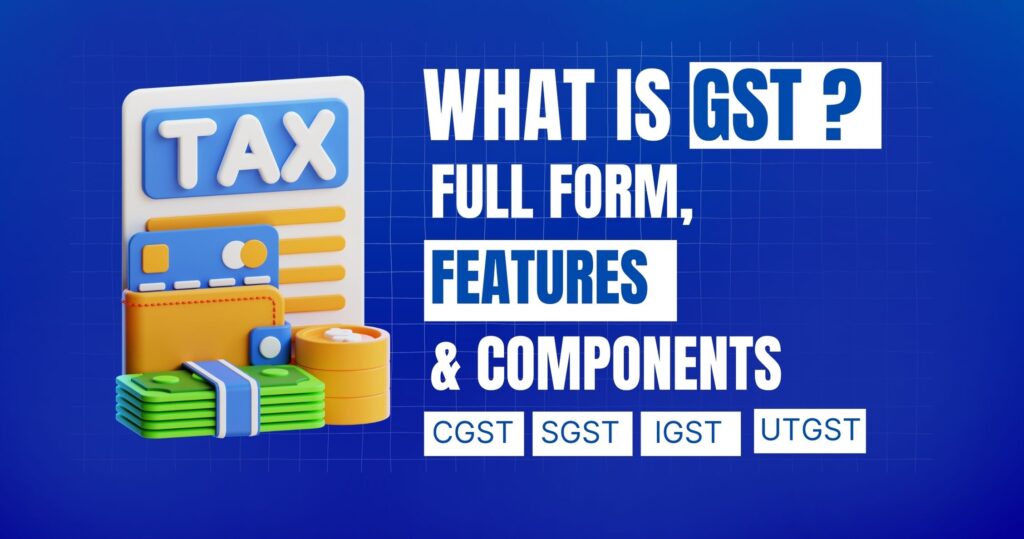The GST introduction in India was thus more revolutionary in terms of changing the country’s indirect tax structure. More colloquially, Goods and Services Tax, or the single tax replacing various other indirect taxes to smoothen and simplify the tax collection process, easing compliance for all scaled companies across the nation, is referred to in Hindi as “GST ka full form.”.
In this article, we will explain what GST is, what it stands for, its characteristics, its components, and why it is considered one of the most important taxation reforms in Indian history.
Basic Full form of GST
The full form of GST is Goods and Services Tax. GST refers to the indirect duty on taxation that has replaced much of the indirect taxation of the country, such as service tax, VAT, excise duty, etc. The idea behind bringing in GST was to give a uniform tax structure by replacing the complicated multi-layered tax system India had earlier.
CGST’s full form is Central Goods and Services Tax. This is a term a person is going to find pretty often, and it is part of the GST regime. Later in this article, we will explain its role in the whole GST system.
Background: Why was GST Introduced in India?
Goods and Services Tax, or GST, was adopted in the form of the One Hundred and First Amendments of the Constitution of India with effect from 1st July 2017. India’s indirect tax regime, even before the state discharged GST, remained unnecessarily labyrinthine. Various states had different regimes, which consequently caused confusion, and inefficiency, and served as a burden on enterprises, especially those that required inter-state trade. This also means much higher consumer prices because of the tax-on-tax effect or cascading effect.
GST was, therefore, brought in to overcome these difficulties by subsuming these multiple taxes into one and making the taxation system far more transparent, effective, and business-friendly.
Components of GST
In India, GST is a broad-based and destination-based, multi-point tax. In order to understand the different aspects of GST it has to be broken down into its components. The components of GST are:
| CGST | Central Goods and Services Tax |
| SGST | State Goods and Services Tax |
| IGST | Integrated Goods and Services Tax |
| UTGST | Union Territory Goods and Services Tax |
Each of these has a different role and application for accomplishing the end goal, that is, to keep the wheel of the whole tax machinery running smoothly all over the country.
1. CGST: Central Goods and Services Tax
CGST means Central Goods and Services Tax, which is the tax imposed by the central government intra-state on the supply of goods and services. The revenues in every transaction with a state are shared by both the Central and State governments.
For example, when a Delhi-based seller sells products to a Delhi-based buyer, there would be a levy of CGST. The revenues collected on account of CGST accrue to the central government.
2. SGST: State Goods and Services Tax
The intra-state supply within a state attracts the SGST, levied by the state government. In the given above instance, for the same transaction in Delhi, it would attract SGST, apart from CGST revenues that would accrue to the state government.
The main reason behind the introduction of the SGST was to ensure that the state governments do not incur any revenue loss, for this would integrate the systems and provide federalism to the states at the same time.
3. IGST: Integrated Goods and Services Tax
This is with regards to the inter-state supply of goods or services and also said to be any trade between two states or across state borders. Imports and exports also come under IGST. To be kept in mind is that while both CGST and SGST are levied on intra-state supply, it is IGST that is collected by the Central Government, which after collection divides it with the Center and the States.
If, for example, a dealer in Maharashtra sells goods to a consumer in Karnataka, then it will attract IGST
4. UTGST: Union Territory Goods and Services Tax
Instead of SGST, UTGST is levied in union territories where state laws are not applicable. UTGST will be levied in union territories such as Chandigarh, Lakshadweep, etc. It is the same as the working of the SGST but collected and dealt with by the administration of the union territories.
Key Features of GST
GST’s features clearly demonstrate why it was considered a landmark reform in India’s indirect taxation system. Here are some key features:
Comprehensive Indirect Tax
GST is a single tax that replaces most indirect taxes, including Central Excise Duty, Service Tax, VAT, and many others. In simple terms, it is one single tax that has made the compliance to taxation easier for the business houses, who require looking only at GST instead of multiple taxes.
Destination-Based Taxation
GST, a consumption-based tax, differs from the previous origin-based tax system. That means, the levy of tax is at the last stage of consumption. It precludes cascading, that is, businesses would not pay taxes at every stage on raw materials and intermediates to move the products or service downstream.
Dual GST Structure
India is following a dual GST structure whereby intra-state supply of goods and services attracts taxation levied by both the Center through CGST and by State through SGST. In this way, the central and state government will have a revenue-sharing model and at the same time keep the tax structure unified.
Input Tax Credit (ITC)
The main advantages of GST come with the Input Tax Credit system. Businesses can claim the ITC on the taxes paid for inputs, which minimizes the overall tax burden besides avoiding a cascading effect of the taxes. It also introduces transparency and speeds up compliance.
Simplified Registration and Compliance
The online GST Network has made registration easier.
Threshold for Registration
With the advent of the online GST Network, registering has become simpler. In case the annual turnover of an entity exceeds ₹40 lakh (₹20 lakh for services in some states), then such an entity needs to get itself registered under GST. Small businesses below this limit may also, at their option, go in for the Composition Scheme and pay lower rates of tax with lesser compliance.
Harmonised System of Nomenclature, HSN code
This includes the HSN code for every product, adding a more sorted manner of classification of goods. This will ensure the commodities that are alike in their form will fall under one single classification which helps in the application of tax and lessens disputes.
Anti-Profiteering Measure
In this context, the government has adopted anti-profiteering measures for GST to ensure businesses pass the benefits of reduced tax burdens and lower input costs to consumers. Businesses are expect to reflect the cost reduction in their pricing, and violations may result in penalties.
Rates under GST
GST mainly falls under four major tax slabs:
| 5% |
| 12% |
| 18% |
| 28% |
These tax slabs include goods and services based on their nature. That means the government taxes essential food items at 0% or 5%, while luxury items like cars and tobacco fall under a higher tax slab of 28%.
Advantages of GST
After discussing the features of GST, it would be appropriate to look at the major advantages that make this taxation system beneficial for the business concerns, consumers, and the economy at large.
Elimination of Cascading Effect
The great advantage of the GST system is that it eliminates the cascading effect of taxes. Integrating all taxes into one function ensures that taxation applies only to the value added at each stage.
Increased Compliance
Ease in the tax filing process and availability of ITC would more like to encourage businesses to comply with the payable amount of tax. This, in turn, would increase the tax base and reduce the scope of tax evasion.
Uniform Tax Structure
The GST creates a single national market by unifying different states. This will undoubtedly ease business across state borders without concerns about varying tax structures in different states.
Boost to Economic Growth
Thus, GST incentivizes supply chains to become more efficient, cutting the costs of goods and services. Removing inefficiencies from the previous system also saves businesses money, which they pass on to consumers as lower prices. This, in turn, would spur consumption and thus begin to contribute to growth.
Support for Small Businesses
Under GST, small business enterprises could avail of the Composition Scheme, making them pay at a lower rate and reduce compliance. This, in turn, will foster entrepreneurship and give a fillip to small and medium enterprises.
Conclusion
The introduction of the GST was a revolution in the field of taxation. GST, in short, implies Goods and Service Tax, from which one can understand that the purpose of its introduction was to put all indirect taxes under a single roof. It is ideas like dual GST, Input Tax Credit, and destination-based taxations that have made compliance easier, thus reducing the burden on businesses to a great extent.
Though at its teething stage, the system has had its own share of problems. Large sections view it as a necessity and a much-needed step toward transparency and compliance, giving a fillip to economic growth. GST, through its constituent parts comprising CGST, SGST, IGST, and UTGST, makes certain uniformity in tax structure across the country for businesses and consumers at large.
In substance, the Goods and Services Tax turned India into a ‘single marketplace’ and brought clarity to the need for ease of doing business that will contribute towards the prosperity of the nation in the long run.
Read other Blogs : Renew Your HDFC ERGO Health Insurance Online


3 Responses